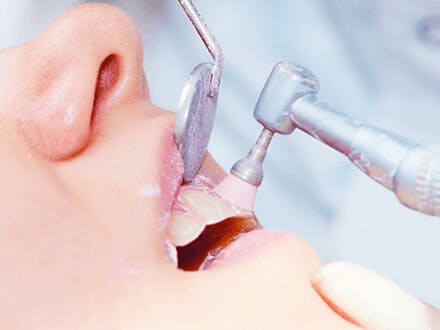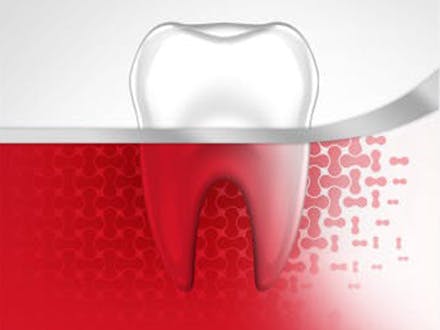Gum Disease Treatment Options
Gum disease can lead to problems when left untreated. However, if dealt with early on, the effects are reversible. Practicing good oral hygiene and making regular visits to a periodontist can also help prevent gum disease.1
There are two types of gum disease: gingivitis and periodontitis. Gingivitis is the milder form of gum disease but can progress into periodontitis if left untreated.2 Gum disease treatment may vary depending on the severity of the disease.2 Gum disease can be treated surgically or non-surgically.3 Below, we’ll walk through the different options when it comes to surgical and non-surgical gum disease treatment.

Good Oral Hygiene
The best way to deal with gum disease is to prevent it from ever taking hold. A thorough routine at the sink makes a huge difference. Brush your teeth and tongue after meals to help remove the food particles and other bacteria that may be present.1 Floss to reach the food particles and plaque between your teeth and along your gum line that your toothbrush doesn’t catch.1 You can add mouthwash to your regular brushing and flossing routine for further protection against gum disease.1

Gum Health Toothpaste
Using a Gum health daily toothpaste can help reduce bleeding gums and lower plaque levels. Make sure you’re brushing your teeth twice every day and replacing your toothbrush every three to four months, or when the bristles become frayed.5

Regular Dental Visits
Regular check-ups and teeth cleanings from your dentist and periodontist can help diagnose problems early on.4 It is possible to have gum disease without any pain or other symptoms, which is why seeing a dental specialist is so important.4 If you notice bleeding gums, swollen or tender gums, gums that are pulling away from your teeth, a change in how your teeth fit together, or bad breath that doesn’t go away, talk to your dentist or periodontist and get the issue checked out.4

Surgical Treatment
If gingivitis advances to periodontitis, gum tissue will not respond to brushing and regular oral hygiene. One or more of the following oral surgery procedures may be required:6
Gum graft surgery. If gum recession occurs, a periodontist can perform a gum graft surgery to cover the exposed tooth root. This procedure helps prevent bone loss and additional gum recession.
Periodontal pocket procedure.This surgical procedure works to remove any gum-disease causing bacteria around the tooth and refit a loosened gum around a tooth. If the bone has been damaged and created an irregular surface, this procedure may also include smoothing down the disease-damaged bone so that bacteria doesn’t continue to grow.
Regenerative surgical procedure.If gum disease has damaged or destroyed the bone that supports your teeth, you may be eligible for a procedure that stimulates the regrowth of gum tissue and bone by adding a membrane, bone graft, or tissue-stimulating protein to encourage the body’s natural ability to regenerate bone and tissues.
Non-Surgical Treatment Options
In addition to practicing preventative oral hygiene, there are other non-surgical treatment options for gum disease including the following:7
Laser treatment.Although research is ongoing, studies on using lasers as an alternative to gum surgery have shown promising results in the treatment of gum disease.
Scaling and root planing.In this procedure, a periodontist uses a combination of scaling below the gum line and planing the tooth root to deep clean and help prevent the future growth of disease-causing bacteria.
How parodontax Toothpaste Works
parodontaxTM is a toothpaste that is clinically proven to help reduce bleeding gums. When used twice daily, it significantly reduces plaque and bleeding gums after 12 weeks.
1. Gum Disease Prevention. American Academy of Periodontology. https://www.perio.org/for-patients/gum-disease-information/gum-disease-prevention/. Accessed 6/8/2022.
2. Gum Disease Information. American Academy of Periodontology. https://www.perio.org/for-patients/gum-disease-information/. Accessed 6/8/2022.
3. Periodontal Treatments and Procedures. American Academy of Periodontology. https://www.perio.org/for-patients/periodontal-treatments-and-procedures/. Accessed 6/8/2022.
4. Gum Disease. MouthHealthy. https://www.mouthhealthy.org/en/az-topics/g/gum-disease. Accessed 6/8/2022.
5. Brushing Your Teeth. MouthHealthy. https://www.mouthhealthy.org/en/az-topics/b/brushing-your-teeth. Accessed 6/8/2022.
6. Surgical Procedures. American Academy of Periodontology. https://www.perio.org/for-patients/periodontal-treatments-and-procedures/surgical-procedures/. Accessed 6/8/2022.
7. Non-Surgical Treatments. American Academy of Periodontology. https://www.perio.org/for-patients/periodontal-treatments-and-procedures/non-surgical-treatments/. Accessed 6/8/2022.
How parodontax Toothpaste Works
parodontaxTM is a toothpaste that is clinically proven to help reduce bleeding gums. When used twice daily, it significantly reduces plaque and bleeding gums after 12 weeks.





